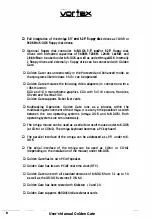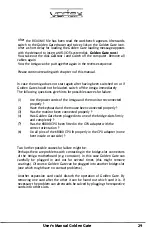
\. .if==E� ; - -=--:
Vi..-ii 5 ��
Which are the differences between base, extended and expanded rnemory
?
Before the introduction of the 80286 microprocessor, all MS-DOS programs
and the MS-DOS operating system itself had been restricted to 640KB of
memory. These 640KB represented the complete amount of RAM at the
user's disposal. Thus under MS-DOS programs, data and MS-DOS itself had
to be small enough to occupy no more than 640KB.
More memory was needed. The only way to control more me_mory making
sense consisted in developing new, more powerful microprocessors (286,
386, 486) and operating systems layed out for them. The crucial point was
(and still is) to keep both compatible to their respective predecessors. This
is one reason why we still have the 640KB limit today.
Extended memory is a special memory above 640KB and it is only available
in computer systems equipped with at least a 80286 microprocessor. MS
DOS and MS-DOS programs require a special driver (e.g. HIMEM.SYS) in
order to be able to address this memory. The advantages of an extended
memory are a fast access and a continuous and coherent address space.
Almost all newly developed or newly written programs preferably use
extended memory and not expanded memory (e.g. Windows 3, Lotus 1-2-3).
Expanded memory has been introduced at a time when our PC's were
equipped with a 8088 or 8086 microprocessor ( ... good old days) and
solutions to get more memory were looked for. Expanded memory is
mapped in a certain block size and an address window by a certain
hardware and software.
It would be wrong to claim expanded memory was antiquated or old, but
the trends in the development of new software unambiguously show that it
is extended memory that is dominant (Windows 3 is probably the most
popular development).
Can the Amiga also use the
RAM
of Golden Gate
?
Yes!
2MB or 4MB of Golden Gate's own RAM can be used as an autoconfiguring
Amiga RAM expansion.
As a
rule of thumb and also taking into consideration the costs and
flexibility
it is certainly much better to upgrade Golden Gate with RAM than
the Amiga
(on the motherboard or with a Zorro slot expansion).
Of
course,
it is clear that the amount of Golden Gate's RAM used by the
Amlaa Is
no longer available for MS-DOS.
User's Manual Golden Gate
17
Summary of Contents for Golden Gate 386SX
Page 32: ...Illustration 3 3 a 30 V 1 User s Manual Golden Gate ...
Page 33: ...Illustration 3 3 b _ s s User s Manual Golden Gate 31 ...
Page 34: ...1 11 Illustration 3 3 c 32 User s Manual Golden Gate ...
Page 35: ... __ lSF Illustration 3 3 d User s Manual Golden Gate 33 ...
Page 36: ...Illustration 3 3 e 34 User s Manual Golden Gate ...
Page 37: ...Illustration 3 3 f User s Manual Golden Gate 35 ...
Page 41: ...Illustration 3 4 A _ _ User s Manual Golden Gate 39 ...
Page 42: ...Illustration 3 4 b 40 User s Manual Golden Gate ...
Page 43: ...Illustration 3 4 c ff r User s Manual Golden Gate 41 ...
Page 44: ...Illustration 3 4 d 42 User s Manual Golden Gate ...
Page 48: ...illustration 3 5 b 46 User s Manual Golden Gate ...
Page 51: ...i lllust rat 1011 U a v r x 0 t1 0 t t1 1 0 User s Manual Golden Gate 49 I BOC38 ...
Page 52: ...y_ Illustration 3 6 b 50 User s Manual Golden Gate ...
Page 55: ...11 luslratlon 3 7 b F a User s Manual Golden Gate 53 ...
Page 57: ...VI VI 01 I Floppy Disk I I Illustration 3 7 d User s Manual Golden Gate ...
Page 59: ... 0 Illustration 3 8 a _Jr r j D I l I tJ I n User s Manual Golden Gate 0 57 ...














































